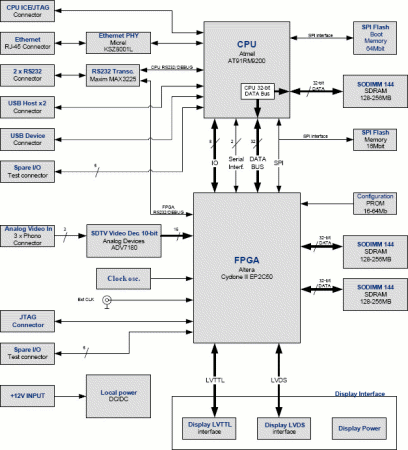Development board aims Linux at graphics-intensive apps
Dec 21, 2006 — by LinuxDevices Staff — from the LinuxDevices Archive — 1 views Bitsim is shipping an evaluation and development board that targets 2D graphics-intensive embedded applications, such as instrumentation and gaming devices. The “Badger” board is based on an ARM9 processor and Altera Cyclone II FPGA (field-programmable gate array), and apparently is accelerated by Bitsim's “Badge” softcore… processor.
Bitsim is shipping an evaluation and development board that targets 2D graphics-intensive embedded applications, such as instrumentation and gaming devices. The “Badger” board is based on an ARM9 processor and Altera Cyclone II FPGA (field-programmable gate array), and apparently is accelerated by Bitsim's “Badge” softcore… processor.
(Click for larger view of the Bitsim Badger)
Bitsim's Badge technology appears to be a graphics processing unit (GPU) softcore that runs in the Altera FPGA, and provides a variety of advanced 2D acceleration features, including analog and digital video acceleration, anti-aliasing, and alpha blending and text overlay. Badge supports Linux and Windows CE, and also has an API for use without an OS, according to Bitsim. It can handle single or multiple video streams, with text, symbols, and menus overlaid on video windows. Graphics content can optionally be stored as compressed data.
The Badger board is based on at Atmel AT91RM9200, which features an ARM9 core clockable to 180MHz. The board also has an Altera Cyclone II EP2 C50 SPI, on which the Badge IP (intellectual property) runs. An evaluation copy of Badge comes with the board.

Bitsim Badger diagram
(Click to enlarge)
Additional touted features include:
- 128-256 Mbytes 133MHz SDRAM
- 2 + 8 Mbytes Serial Flash
- I/O includes Ethernet, USB, RS232, JTAG, LVDS, and lots more
- Connectors for displays, GPIO, debug, and extensions
- “Video signals directly into the board”
Availability
The Badger board is available now, along with demo applications, schematics, and reference materials. Pricing was not disclosed.
This article was originally published on LinuxDevices.com and has been donated to the open source community by QuinStreet Inc. Please visit LinuxToday.com for up-to-date news and articles about Linux and open source.